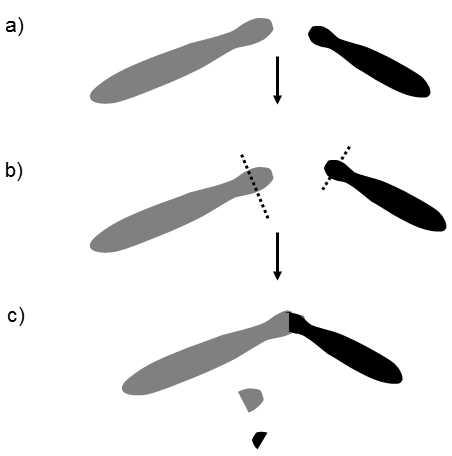III.5.3.2 Extensive translocations can be manifested as genome mutations and can alter the karyotype of the individual
Translocationsof major extent can even be manifested in the structure of entire chromosomes.Simultaneously, classical cytogenetic methods can be employed to determine the occurrence of fusion or fission of chromosomes, i.e. processes entailing a change in the number of chromosomes in a chromosome set without a simultaneous change in the amount of DNA in the genome.A change in the number of chromosomes is not usually manifested in the phenotype of the organism, but often acts as a strong interspecies barrier.
Robertson transloctionis an interesting type of chromosome mutation in which one chromosome with a centromere in the vicinity of the centre (metacentric chromosome) is formed from two chromosomes with centromeres in the vicinity of the ends of the arms (metacentric chromosomes) (Fig. III.4).However, the altered karyotype contains one less chromosome, where the number of chromosomal arms does not change.There are a number of species, the best known of which are, e.g., the house mouse, in which the occurrence of local populations with one or more Robertson translocations is very common (Zima et al. 1990).It is very probable that meiotic drive is responsible for spreading of these chromosomal mutations (see VI.3.5) (Zimmering, Sandler, & Nicoletti 1970; Prout, Bundgaard, & Bryant 1973; Thomson & Feldman 1974), i.e. a phenomenon in which meiosis does not occur completely evenly and one of the pair of homologous chromosomes enters the sex cells preferentially.In case of polymorph populations, in which a certain chromosome with a Robertson translocation occurs and simultaneously two original unfused chromosomes are present in other individuals, it can readily happen that, in a heterozygote with two acrocentric and one metacentric chromosome, the metacentric chromosome will enter the sex cells with greater (in other species with lower) probability during meiosis (Gropp, Winking, & Redi 1982; Everett, Searle, & Wallace 1996).In this case, the particular type of chromosomes will spread in the population even under conditions when the heterozygotes will have reduced fertility compared to the original parent form because of the formation of part of the gametes with an incomplete (aneuploidal) chromosomal set – cf. the blue beard model (IV.9.1).

Fig. III.4. Robertsonian translocations. The formation of a metacentric chromosome (c) through a Robertsonian translocation, i.e. fusion of two acrocentric chromosomes (a) where breakage has occurred in the area of the centromere (b).
